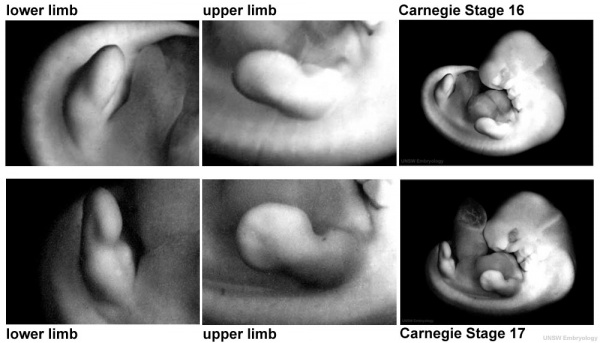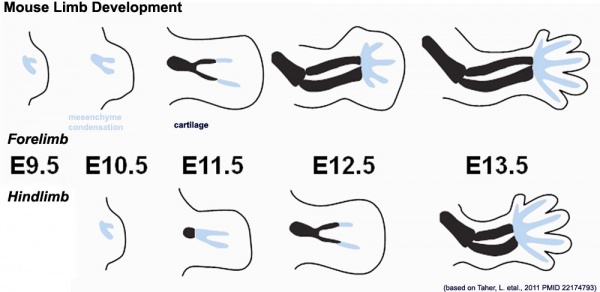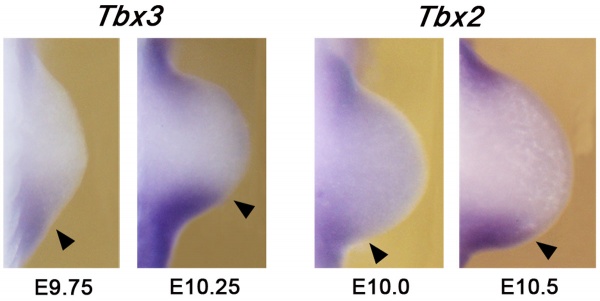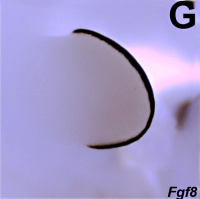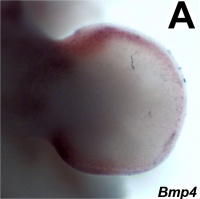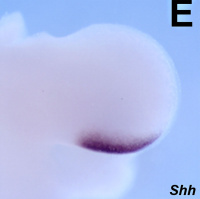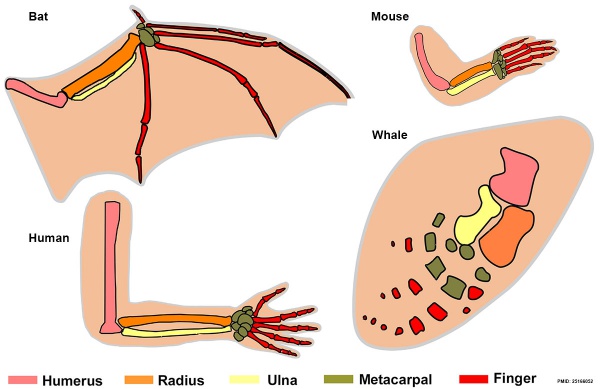K12 Limbs
| Embryology - 19 Apr 2024 |
|---|
| Google Translate - select your language from the list shown below (this will open a new external page) |
|
العربية | català | 中文 | 中國傳統的 | français | Deutsche | עִברִית | हिंदी | bahasa Indonesia | italiano | 日本語 | 한국어 | မြန်မာ | Pilipino | Polskie | português | ਪੰਜਾਬੀ ਦੇ | Română | русский | Español | Swahili | Svensk | ไทย | Türkçe | اردو | ייִדיש | Tiếng Việt These external translations are automated and may not be accurate. (More? About Translations) |
Limbs - Arms and Legs
The arms and legs (we call them "limbs") begin as small buds on the sides of the embryo body. This page will describe the genes associated with limb development. What we now know is that the same patterning genes are used by all animals that form limbs.
Many of these patterning genes are "transcription factors", that is they are molecular switches that can turn on families of other genes in the cell associated with that developmental process. Pattern signalling occurs before we see the limb features develop.
Human Limb Development during week 6
Human Limb Development during week 8
From week 5 to week 8 of development, changes occur in the shape and structure of the embryo limbs. In humans by the end of this time the basic limb structure has been formed, most of the rest of prenatal growth is an increase in size.
The arms begin to develop before the legs. If you look at the whole embryo the legs always look younger (less developed) than the arms (almost a stage behind, about 2 days difference).
The same upper before lower is seen in the mouse and other species.
Now look above at the human limb and see what changes you can see in the shape, features and position of the arm and leg.
Towards the end of this time (9 weeks) the embryo will also begin to move the arms and legs.
Limb Position
Positioning of where the limbs will be along the length of the embryo is determined by the specific expression of Homeobox (Hox) genes.
This can turn on growth factor expression (Fibroblast growth factor, FGF) that leads to the local growth of the limb in the embryo.
Limb Identity
Whether an upper (arm) or lower (leg) will form at that location is controlled local expression of T-box (Tbx) genes.
| Mouse embryo limb Tbx (blue) Expression |
|
Limb Pattern
Inside both the upper and lower limb similar patterning mechanisms are then used to form the 3 dimensional (3D) structure of the limb. This patterning in all animals has the same genetic controls expressed in localised regions of the developing limb.
This "patterning" forms the 3 main axes of the limb.
Different Species Limbs
This cartoon shows the comparative anatomy of bones within the upper limb of 4 different species.
Words Used
arm - the upper limb or in animals the forelimb. (In anatomy, this is only the part between shoulder and elbow)
digit - word used to describe either the finger or toe.
leg - the upper limb or in animals the hindlimb. (In anatomy, this is only the part between hip and knee)
limb - word used to describe either the arm or leg.
limb bud - the first time you can see on the embryo surface where the arm or leg will form. It looks like a "bud" or "paddle" without any features.
Cite this page: Hill, M.A. (2024, April 19) Embryology K12 Limbs. Retrieved from https://embryology.med.unsw.edu.au/embryology/index.php/K12_Limbs
- © Dr Mark Hill 2024, UNSW Embryology ISBN: 978 0 7334 2609 4 - UNSW CRICOS Provider Code No. 00098G

